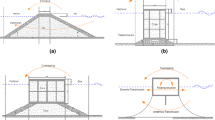Abstract
The concepts of floating structure plays a very important role in deepwater projects; and the design of the floating structure is one of the most important tasks in the project. The importance of the floating structure in offshore projects can be demonstrated in the following several areas: the substantial dynamic structure responses due to wave loading and current loading; the limited motion requirements of risers in deep water; and the increasing difficulty of installation for different components of the system. Three major technical aspects have to be considered, i.e. the strength of structure, the fatigue resistance capacity of the system, and local and global stability of the structure. This paper reviews the current design practice of floating structures, evaluates the main tasks during the design and associated major technical requirements, and addresses the major technical challenges encountered during the design. As a close-out of the paper, the authors discuss some potential future developments in the design of floating structures.
摘 要
浮式平台概念的选择及其结构设计是深水工程项目的关键环节之一。 它决定了平台在波浪载荷作用下的动力学响应、 立管在深水条件下的运动以及进行平台建造与安装的技术难度等。 结构强度、 结构的抗疲劳性能以及结构的整体和局部稳定性能是浮式平台设计必须重点考虑的三个主要方面。 总结了当前浮式平台设计的主要方法和它的主要任务以及技术要求, 着重分析了设计过程中的主要技术难点及重点; 最后, 讨论了浮式平台结构设计的潜在发展趋势。
Similar content being viewed by others
References
ABS. Guide for building and classing floating production installations (FPI)[S]. Houston: American Bureau of Shipping, 2004.
ABS. Rule for building and classing mobile offshore drilling unit (MODU)[S]. Houston: American Bureau of Shipping, 2006.
ABS. Guide for the fatigue assessment of offshore structures[S]. Houston: American Bureau of Shipping, 2003.
Health and safety executive. Offshore installations: guidance on design, construction and certification[M]. 4th ed. Sudbury, 1995.
DNV. Structural design of offshore units (WSD method). OS-C201[S]. Oslo: Det Norske Veritas, 2002.
American Petroleum Institute. API RP-2T Recommended practice for planning, designing, and constructing tension leg platform[S]. Washington, D C: API Publishing Services, 1997.
Author information
Authors and Affiliations
Corresponding author
Additional information
Foundation item: Supported by China National 111 Project Under Grant No. B07109.
ZHANG Da-gang was born in 1962. He got his PhD at the University of California, Berkeley in 1990. He is a professor at Harbin Engineering University. His current research interests include deepwater floating structure design and analysis; floating platform fabrication and installation; deepwater project management, etc.
Rights and permissions
About this article
Cite this article
Zhang, Dg., Deng, Zc. & Yan, Fs. An introduction to hull design practices for deepwater floating structures. J. Marine. Sci. Appl. 8, 123–131 (2009). https://doi.org/10.1007/s11804-009-8103-3
Received:
Published:
Issue Date:
DOI: https://doi.org/10.1007/s11804-009-8103-3




